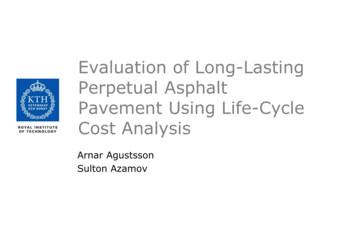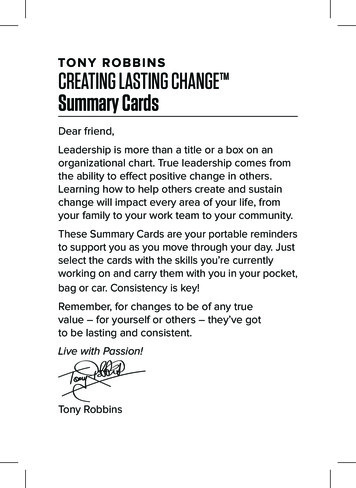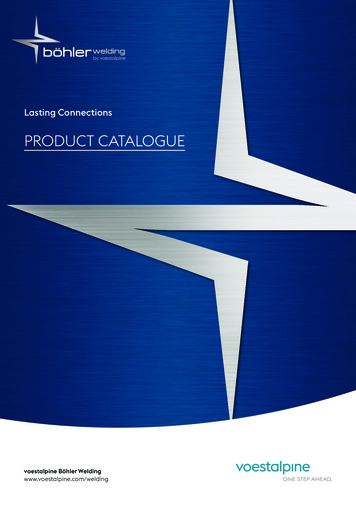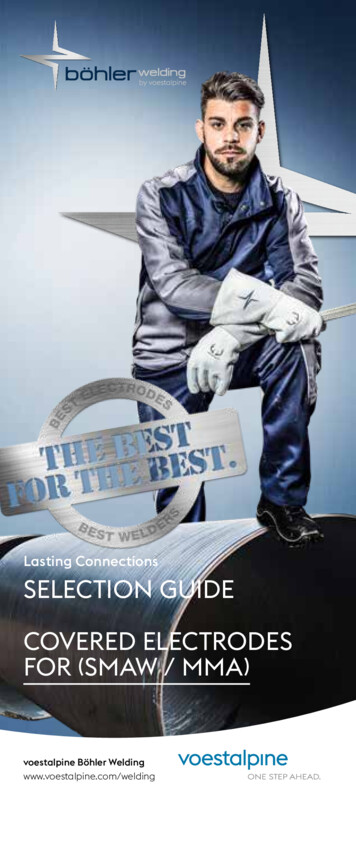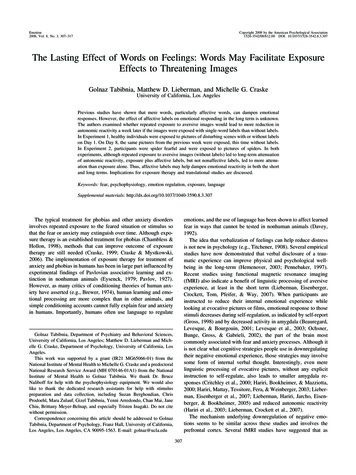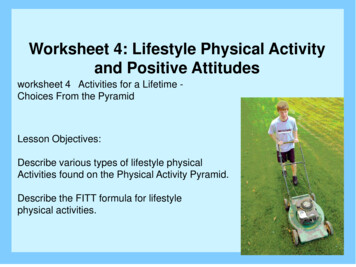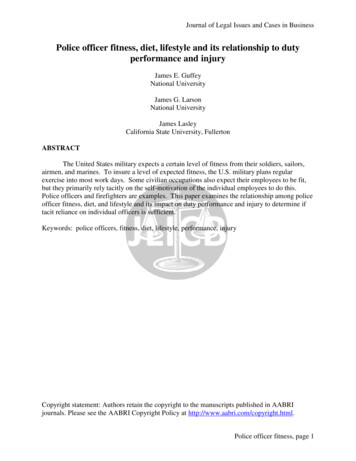
Transcription
AP u b l i c a t i o no ft h eW e l l n e s sC o u n c i lo fA m e r i c aWELCOA'sHow To Influence Lasting Lifestyle Change:The Benefits ofPart OneOf An Interview WithDr. Michael ArloskiOn The Art & ScienceOf CoachingFor more interviews, visitwww.welcoa.org
ABOUT MICHAEL ARLOSKI, PhD, PCC, CWPDr. Michael Arloski is CEO of Real Balance Global Wellness Services (www.realbalance.com) and dean of the Wellness Coach Training Institute. He is alicensed psychologist and professional certified coach with over 30 years ofprofessional contribution to the field of wellness. Thousands of wellness andhealth coaches worldwide have been trained by his company’s program,which is recognized and approved by The International Coaching Federation, The AmericanCollege of Sports Medicine, The American Holistic Nurses Association and The NationalCommission for Health Education Credentialing.Dr. Arloski is the author of Wellness Coaching For Lasting Lifestyle Change, a foundational bookof the wellness coaching field used by many universities and training schools. Michael is anAdjunct Professor in Integrative Health Studies at The California Institute for Integral Studies,and is a member of the National Wellness Institute Service. He is a founding member of theleadership team of the National Consortium for Credentialing Health & Wellness Coaches.WELCOA'sAn Expert Interview withMichael ArloskiABOUT DAVID HUNNICUTTSince his arrival at WELCOA in 1995, David Hunnicutt has interviewedhundreds of the most influential business and health leaders in America.Known for his ability to make complex issues easier to understand, Davidhas a proven track record of asking the right questions and getting straightanswers. As a result of his efforts, David’s expert interviews have beenwidely-published and read by workplace wellness practitioners across the country.David Hunnicutt can be reached at dhunnicutt@welcoa.org.
W E LCOAN E W S&V I E W SWhen it comes to workplace wellness programs, health coachingcan make a huge impact on employee lifestyle change.Unfortunately, despite its popularity, far too many companiesdon’t realize how to fully harness the power of coaching. WELCOA presidentDr. David Hunnicutt recently sat down with professional wellness coach andCEO, Dr. Michael Arloski, to talk about the benefits wellness coaching canbring to existing workplace health initiatives.In part one of a two-part interview, Dr. Arloski draws on his more than30 years of experience in the field to share some fundamentals of wellnesscoaching. Dr. Arloski discusses what characteristics make for a good wellnesscoach and how the process works—sharing his foundational 7-step lifestyleimprovement model. This WELCOA Expert Interview brings you bestin-class tips from a pioneer in the wellness coaching field, so you can learnmore about implementing and achieving results through wellness coachingprograms.The Wellness Coach Training Institute Is A WorldLeader In Wellness AndHealth Coach TrainingThe Wellness Coach Training Institute, powered by Real BalanceGlobal Wellness Services LLC, willhelp you to develop or accesstraining, methodologies andstrategies for making your wellness efforts more effectivethrough wellness coaching. TheWellness Coach Training Insti-Dr. David Hunnicutt: What characteristics make a good coach?tute’s certification training is approved by such major health andMichael Arloski: For some, coaching just comes naturally. People-oriented typesof folks are usually attracted to coaching, and for them, coaching is a natural fit.Good coaches are also naturally empathic, warm, genuine and very real. They areable to connect with other people.coaching organizations as the ICF,Also, I think good coaches have achieved what I call a ‘mindset shift.’ They are ableto let go of their attachment to being the expert, and instead they allow their clientto take the lead. These coaches provide structure and assistance, but it is ultimatelythe client who gets to where they need to be. Coaches with this mindset shiftdon’t force their clients to follow every directive and detail theyhave mapped out.Real Balance Global WellnessServices, LLCASCM, AHNA and NCHEC.Contact Them Today!The Wellness Coach Training Institute1-866-568-4702www.realbalance.comReading a copy?Coaches provide structureand assistance, but it isultimately the client whogets to where theyneed to be.Download the original article ategory 16www.welcoa.org3
WELCOAN E W S&V I E W SDH: What does the coaching process look like?MA: A real process has a beginning, a middle and an end.Wellness Coaching ForLasting Lifestyle ChangeIs The Industry StandardFor Wellness CoachingIn this foundational wellnesscoaching book, Dr. Arloski blendsthe principles of wellness promotion and personal life coaching inan easy-to-use training tool. Well-The Beginning: As wellness coaches, we place a lot of focus on the beginning.We help a client with their own exploration and self-assessment. Rather than justassessing and diagnosing them, we help the client explore, get in touch and takestock of their wellness. After we help them understand where they are, we canhelp them clearly understand where they want to be. Life coaching and wellnesscoaching are really all about establishing your vision of health and wellness. Wewant to help clients establish how they would really like to live their lives. We helpclients identify what exactly has to change to achieve that vision, which is what wecall coaching to the gap—the gap between where you are now and where you wantto be in the future.ness Coaching for Lasting LifestyleChange is perfect for: wellnessprofessionals, professional coaches, managers, EAP professionals,counselors, and wellness educators. The coaching processes outlined in the book help coachesempower clients to draw on theirown abilities to make lastingchanges for better health.We help a client with their ownexploration and self-assessment.Rather than just assessing anddiagnosing them, we help the clientexplore, get in touch and take stock oftheir wellness.Order Your Copies shtmlPass it on!Know someone who would enjoy this?Click here to send them a copy.42012 Wellness Council of America The Middle: After we help clients identify the gap, we help them formulate a plan.And as coaches we may come up with a wonderful wellness plan: “Here is how toexercise. Here is how to eat.” And of course, that is wellness, but it is not wellnesscoaching. The coaching approach involves working with the client to help themdevelop their own plan. We help them develop a wellness plan that has specificdetails and processes that will enable them to move forward. We essentially helpeach client create their own map to follow—one that is co-created with the clientand the coach.
W E LCOAThe Final Stages: Lastly, we support the client through the plan. We do not justgive someone a good direction, pat them on the shoulder and say “Go ahead andclimb that mountain all by yourself.” We climb the mountain with them. Westick with them through the behavioral change process, providing accountabilityand support. That is the ongoing relationship that is really the heart and soul ofcoaching.N E W S&V I E W SYou Can Become WELCOAFacultyIf you’re a WELCOA member andWe do not just give someone a gooddirection, pat them on the shoulderand say “Go ahead and climb thatmountain all by yourself.” We climb themountain with them.DH: Can you share with our readers a little bit about the lifestyleimprovement model outlined in your book?MA: 1. Self-Assessment. The whole process starts with a self-assessment—a realawareness of your health, a really conscious idea of where you are at. Of course,not everyone is terribly self-reflective. For example, I had two clients who neededto lose a tremendous amount of weight; 100 pounds for one person and 60pounds for the other. Neither one was very self-reflective. However, by doingthe self-assessment, they got a really clear idea of where they were at, where theywanted to go and what they needed to accomplish. They were wonderful attracking their behavior, activity level, calorie expenditure and so forth. They madetremendous progress.you take part in four or more ofWELCOA’s nationally-recognizedcertification courses, you can earnthe elite title of WELCOA Faculty!The WELCOA Faculty designationcredits those who strive to buildeffective, results-oriented wellness programs that change livesand transform organizations.Check out WELCOA’s trainingschedule, hpRead more about membership:www.welcoa.org/member/benefits.phpLog on to the nation's premierwebsite for workplace wellness!www.welcoa.orgwww.welcoa.org5
WELCOAN E W SWELCOA Offers PremierWebinarsEvery year, WELCOA offers adynamic webinar and certification series—with exciting topicsdesigned to help you build andsustain results-oriented wellnessprograms. Each session, conducted by an expert in the field,is offered in a convenient webinarthat allows you to take part in thenation’s premier worksite wellness training from the comfort ofyour office!Check out WELCOA’s webinarschedule atwww.welcoa.org/consulttrain/about.phpPass it on!Know someone who would enjoy this?Click here to send them a copy.62012 Wellness Council of America &V I E W S2. Foundational Work on Self. People don’t often realize that it’s things like socialisolation or environment that are holding them back from quitting smoking orlosing weight. Perhaps a person moved to a new city, hasn’t made any friends, sojust works all day and then goes home and watches television. When we take a lookat their whole life, by doing what I call “Foundational Work on Self,” it really helps.I think too many times in coaching, we jump into goal setting. However, if wedo that prematurely, we don’t always set the most effective goals. They are notreally the things the person would most benefit from working on. It’s critical totake an inventory of your whole life. You need to assess how satisfied you are in allaspects. It sounds really simple, but it is amazing how it opens people up to theidea of, “Oh, wellness is a lot more than just diet and exercise. It is also about myconnection to other people. It’s about the support I get from my significant other.It’s about the place where I live and the environment I am in.”3. Setting the Focus. Then you have to set a focus. You cannot just assess andexplore forever. Coaches must request some action. To do that, we apply theReadiness for Change theory. That is really essential to identify if the person isready to change and at what stage of change they are in. Going with behaviorswhere readiness is higher ensures more success.I think too many times incoaching, we jumpinto goal setting.However, if we dothat prematurely,we don’t alwaysset the mosteffectivegoals.
W E LCOA4. Working Through Habit and Environmental Support. With readinessfor change factored in, we develop an actual concrete plan with specific goalsand action steps. When we help a person through this phase I call it “WorkingThrough Habits and Environmental Support.” There is so much about behavioralchange that requires lasting support. When you think about it, coaches will onlybe in someone’s life for a brief moment—it’s really like a snap of the fingers, ablink of the eye. So, we want to set them up for success by ensuring they havethat lasting support. We make sure they can answer questions like, “Who can helpyou with this? Who can support you in this?” You know, the saying, ‘friends keepfriends healthy’ is really true.N E W S&V I E W SWELCOA’s eStore Has TheResources You Need ForEmployee Wellness!WELCOA offers the best selection of colorful, easy-to-reademployee resources and well-5. Initial Behavioral Change. After we see that initial behavioral change, we oftensee that people do not always get the support they need. For example, if a marriedcouple is both overweight and one of them begins working on it, the other personis not always so keen about that. They feel almost betrayed that their partner ismoving ahead with lifestyle improvement. This is the moment in time where ourclients really need support. Otherwise, they often give up their positive behaviorchange.ness products. Browse our lead-6. Deeper Work On Self. The next step in the lifestyle improvement model iswhat I like to call “Deeper Work on Self.” If we are doing this right, we helppeople change the way they live their life. That is pretty profound, when you thinkabout it. We help people change their perceptions and develop their new identity.We help people to think, “I am not an overweight couch potato person. I amreally a healthy and vibrant person who can move easily and has energy.” We alsohelp these individuals through the lifestyle and environmental adjustments theymust make.www.welcoa.org/storeing wellness products includingbrochures, lifestyle guides, booksand much, much more—all inone convenient location!Shop WELCOA’s eStore – visit:Reading a copy?Download the original article ategory 16There is certainly a lot they have adjust to—they may have to rearrange who theyhang out with. For example, an overweight person may have great friends, butperhaps they are very sedentary. They may have to find some friends who gobicycling, walking or hiking—who do more active things. We have to help themtake a deeper step here to make this lifestyle change really last.We help people change theirperceptions and develop their newidentity. We help people to think, “I amnot an overweight couch potatoperson. I am really a healthy andvibrant person who can move easilyand has energy.”www.welcoa.org7
WELCOAN E W SWELCOA Created The FirstSocial-Networking Site ForWorkplace WellnessSWELL—a social networking system for the WELCOA Nation—is anew member benefit for 2012!Learn from the collective wisdomof the
Wellness Coaching For Lasting Lifestyle Change Is The Industry Standard For Wellness Coaching In this foundational wellness coaching book, Dr. Arloski blends the principles of wellness promo - tion and personal life coaching in an easy-to-use training tool. Well - ness Coaching for Lasting Lifestyle Change is perfect for: wellness

